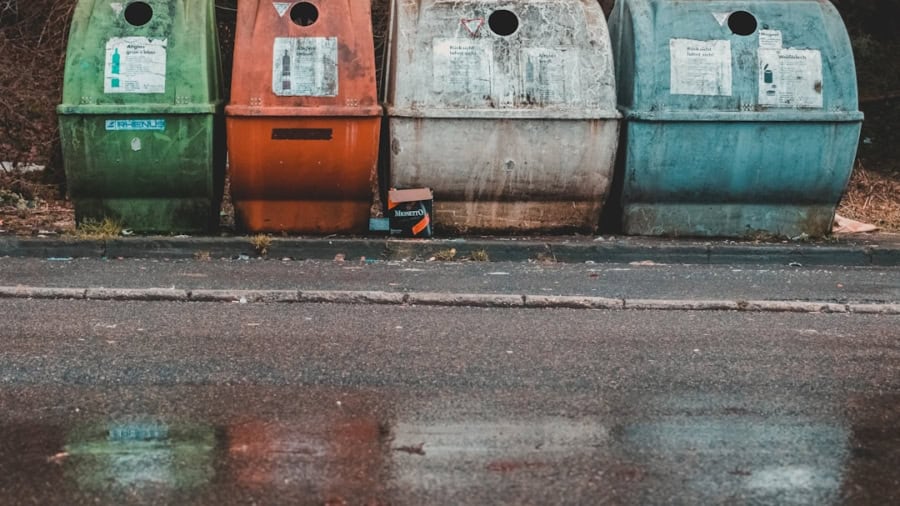The Internet of Things (IoT) has emerged as a transformative force across various sectors, and its application in managing home waste and recycling is particularly noteworthy. As urban populations continue to swell, the challenge of waste management becomes increasingly pressing. Traditional methods of waste disposal are often inefficient, leading to overflowing landfills and environmental degradation.
IoT technology offers innovative solutions that can streamline waste management processes, making them more efficient and environmentally friendly. By integrating smart devices and sensors into waste management systems, households can monitor their waste production, optimize recycling efforts, and contribute to a more sustainable future. The concept of IoT in waste management revolves around the interconnectivity of devices that collect and share data.
Smart bins equipped with sensors can detect fill levels, while mobile applications can provide real-time information on waste collection schedules. This connectivity not only enhances the efficiency of waste disposal but also empowers individuals to take responsibility for their waste habits. As consumers become more aware of their environmental impact, the integration of IoT in home waste management presents an opportunity to foster a culture of sustainability and responsible consumption.
Key Takeaways
- IoT technology can revolutionize home waste management by providing real-time data and automation.
- Implementing IoT in waste management can lead to improved efficiency, cost savings, and reduced environmental impact.
- Challenges of IoT in home waste management include high initial costs, data security concerns, and the need for user education.
- IoT solutions for sorting and recycling household waste include smart bins, sensors, and data analytics to optimize recycling processes.
- IoT plays a crucial role in monitoring and reducing food waste through smart storage systems and expiration date tracking.
Advantages of Implementing IoT in Waste Management
One of the primary advantages of implementing IoT in waste management is the enhanced efficiency it brings to the collection and sorting processes. Smart bins equipped with sensors can monitor fill levels and send alerts to waste collection services when they are nearing capacity. This data-driven approach allows for optimized collection routes, reducing fuel consumption and operational costs for waste management companies.
For instance, cities like San Francisco have begun utilizing IoT technology to streamline their waste collection processes, resulting in significant savings and reduced carbon emissions. Moreover, IoT technology facilitates better recycling practices by providing households with real-time feedback on their recycling habits. Smart bins can be programmed to identify recyclable materials through image recognition technology, guiding users on proper disposal methods.
This not only increases recycling rates but also educates consumers about the importance of separating waste correctly. By leveraging IoT solutions, communities can foster a culture of recycling that extends beyond mere compliance with regulations, encouraging individuals to actively participate in sustainable practices.
Challenges and Limitations of IoT in Home Waste Management

Despite the numerous advantages that IoT brings to waste management, several challenges and limitations must be addressed for its successful implementation. One significant hurdle is the initial cost associated with deploying IoT infrastructure.
Additionally, ongoing maintenance and updates to the system can incur further costs, creating a barrier for widespread adoption. Another challenge lies in data privacy and security concerns. As smart devices collect vast amounts of data regarding waste production and disposal habits, there is a risk that this information could be misused or compromised.
Ensuring robust cybersecurity measures are in place is crucial to protect user data and maintain public trust in IoT solutions. Furthermore, the integration of IoT systems with existing waste management frameworks can be complex, requiring collaboration among various stakeholders, including local governments, waste management companies, and technology providers.
IoT Solutions for Sorting and Recycling Household Waste
Innovative IoT solutions are emerging to enhance the sorting and recycling of household waste. One such solution involves the use of smart bins equipped with advanced sensors and artificial intelligence (AI) capabilities. These bins can automatically identify different types of materials—such as plastics, metals, and paper—using image recognition technology.
By providing real-time feedback on whether an item is recyclable or not, these smart bins help users make informed decisions about their waste disposal practices. Additionally, some IoT platforms offer mobile applications that educate users on proper recycling techniques. These apps can provide information on local recycling guidelines, helping users understand what materials are accepted in their area.
For example, if a user scans a product’s barcode, the app can inform them whether the packaging is recyclable or suggest alternative disposal methods for non-recyclable items. This level of engagement not only simplifies the recycling process but also empowers individuals to take an active role in reducing their environmental footprint.
The Role of IoT in Monitoring and Reducing Food Waste
Food waste is a significant contributor to environmental issues, including greenhouse gas emissions and resource depletion. IoT technology plays a crucial role in monitoring and reducing food waste at the household level. Smart refrigerators equipped with sensors can track food inventory and expiration dates, sending alerts to users when items are nearing spoilage.
This proactive approach encourages consumers to utilize ingredients before they go bad, ultimately reducing food waste. Moreover, IoT-enabled meal planning applications can analyze users’ eating habits and suggest recipes based on available ingredients. By promoting efficient meal planning and encouraging users to make the most of their groceries, these applications help minimize food waste significantly.
For instance, if a user has leftover vegetables from a previous meal, the app might suggest a recipe that incorporates those ingredients, thereby reducing the likelihood of them being discarded.
IoT-enabled Smart Bins and Waste Collection Systems

Optimizing Collection Routes
These innovative bins are equipped with sensors that monitor fill levels, enabling waste management companies to optimize collection routes based on real-time data. By analyzing this information, municipalities can reduce unnecessary trips to empty bins that are not full, leading to lower fuel consumption and decreased operational costs.
Uncovering Waste Generation Patterns
In addition to optimizing collection routes, smart bins can provide valuable insights into waste generation patterns within communities. By aggregating data from multiple bins across different neighborhoods, municipalities can identify trends in waste production and adjust their strategies accordingly.
Data-Driven Decision Making
For example, if certain areas consistently generate more organic waste, local governments can implement targeted composting initiatives or educational campaigns to encourage residents to reduce food waste. By leveraging the power of data, municipalities can develop more effective waste management strategies that benefit both the environment and the community.
The Impact of IoT on Sustainable Waste Management Practices
The integration of IoT technology into waste management practices has far-reaching implications for sustainability efforts. By providing real-time data on waste generation and disposal habits, IoT solutions empower individuals and communities to make informed decisions about their consumption patterns. This increased awareness fosters a culture of sustainability that extends beyond mere compliance with regulations; it encourages proactive engagement in reducing waste at its source.
Furthermore, IoT technology facilitates collaboration among various stakeholders involved in waste management. Local governments can leverage data collected from smart bins to develop targeted policies aimed at reducing landfill contributions and increasing recycling rates. Waste management companies can utilize this data to optimize their operations and improve service delivery.
Ultimately, the interconnectedness enabled by IoT fosters a holistic approach to sustainable waste management that benefits both individuals and communities.
Future Trends and Innovations in IoT for Home Waste and Recycling
As technology continues to evolve, the future of IoT in home waste management holds exciting possibilities. One emerging trend is the integration of machine learning algorithms into smart bins and recycling systems. These algorithms can analyze historical data on waste generation patterns to predict future trends, allowing municipalities to proactively address potential issues before they arise.
Additionally, advancements in blockchain technology may enhance transparency in recycling processes. By creating a decentralized ledger that tracks recyclable materials from collection to processing, stakeholders can ensure accountability throughout the supply chain. This level of transparency could incentivize consumers to participate more actively in recycling initiatives.
Moreover, as smart home technology becomes increasingly prevalent, we may see greater integration between IoT devices used for energy management and those used for waste management. For instance, smart appliances could communicate with smart bins to optimize food storage based on expiration dates or suggest meal plans that minimize food waste.
By harnessing the power of connectivity and data analytics, households can play an active role in promoting sustainability while also benefiting from increased efficiency in their waste disposal efforts. As innovations continue to emerge in this space, we can expect a future where responsible consumption becomes second nature for individuals and communities alike.
In a recent article discussing The Future of IoT in Managing Home Waste and Recycling, it is evident that technology plays a crucial role in creating a more sustainable environment. As we look towards the future, advancements in IoT devices will continue to revolutionize how we manage waste in our homes. For those interested in staying ahead of the curve with the latest technology, consider checking out the best tablet with a SIM card slot or exploring the possibilities of the Samsung Galaxy Z Fold4. These devices showcase the innovative ways technology is shaping our daily lives and can complement the efforts to create a more sustainable future.
FAQs
What is IoT?
IoT stands for Internet of Things, which refers to the network of physical devices, vehicles, home appliances, and other items embedded with sensors, software, and connectivity that enables them to connect and exchange data.
How is IoT used in managing home waste and recycling?
IoT can be used in managing home waste and recycling by implementing smart waste management systems that use sensors to monitor waste levels in bins, optimize collection routes, and provide data for more efficient recycling processes.
What are the benefits of using IoT in managing home waste and recycling?
Some benefits of using IoT in managing home waste and recycling include reducing costs and environmental impact through more efficient waste collection and recycling processes, as well as providing real-time data for better decision-making.
What are some examples of IoT devices used in managing home waste and recycling?
Examples of IoT devices used in managing home waste and recycling include smart bins with sensors that monitor waste levels, connected recycling machines that incentivize recycling, and waste management platforms that provide data analytics for better waste management.
What are the challenges of implementing IoT in managing home waste and recycling?
Challenges of implementing IoT in managing home waste and recycling include the initial cost of implementing IoT devices, ensuring data security and privacy, and the need for infrastructure and connectivity in some areas.

